Kitchen buying guides
Renovating or upgrading your kitchen? With so many options, choosing the right fit can feel overwhelming. Start by envisioning your ideal space—balancing design, functionality, and technology. To make your decision easier, ask yourself these key questions:
FAQs
FRENCH DOOR FRIDGE
French Door Fridges offer spacious storage with their split-door design, perfect for cooling large items. Featuring a bottom-mounted freezer (drawer or doors), French Door Fridges provide easy access, flexible shelving, and adjustable cooling. Many models include a middle "entertainer's drawer" with customisable temperature settings. The 4-door (Quad Door) design further enhances freezer organisation. 1
SIDE-BY-SIDE FRIDGE
This fridge features the fridge and freezer compartments beside each other, both taking up the full length of the appliance, with the doors opening from the middle. These fridges often feature extras such as ice and water dispensers, however due to the layout they sometimes do not lend themselves to wider, larger items like platters. 2
BOTTOM MOUNT FRIDGE
Space often dictates fridge choice, and bottom mount fridges offer convenient access to both fresh and frozen items. With the freezer below, these Bottom Mount Fridges prioritise easy access to frequently used fresh ingredients at the top, eliminating the need to bend for produce or other items typically stored at the bottom. 3
TOP MOUNT FRIDGE
A classic fridge design, the top mount fridge places the freezer above the fresh food refrigerator compartment. Often a more budget-friendly option, top mount fridges also offer the advantage of keeping frozen treats out of reach of children. 4
INTEGRATED FRIDGES
Integrated Fridges are built-in your kitchen cabinetry and its exterior can be custom designed to match the material and finishes of your cupboards. Growing in popularity, both integrated fridges and freezers are available across many brands. When the integrated fridge or freezer is closed, they display a seamless kitchen cupboard design that keeps your kitchen looking minimalist and clean. 5
FREESTANDING FRIDGES
Freestanding fridges and freezers offer unparalleled placement flexibility, requiring no built-in installation and designed to stand alone as stylish additions to any kitchen. Whether positioned next to the pantry or alongside other appliances, these versatile appliances enhance both form and function. While their adaptability is a key advantage, features that requiring plumbing, such as water dispensers or ice makers, are less common in freestanding fridges and freezers. Recognising their popularity, many brands offer matching freestanding fridge and freezer freestanding models, allowing for a cohesive pigeon pair look and providing valuable supplementary storage when needed. 6
Pigeon Pair
A Pigeon Pair refers to a single freestanding fridge or freestanding freezer that are sold as individual units that can be ‘paired’ together to meet your needs. Often from the same brand, you may place two fridges together or have a standalone freestanding fridge and freestanding freezer next to each other to enjoy extra storage space in your kitchen. 7
Chest Freezers
Chest Freezers are great to store extra frozen goods that you might have bought in bulk. They can be placed in the kitchen or another spot in the home like the garage or patio. Chest Freezers are available in a variety of sizes for domestic use. Some features to look for in chest freezers could include lift-out baskets and/or vertical dividers to help your packing of the freezer. 8
Bar Fridges
If you need more space for drinks why not consider a Bar Fridge. You can store your drinks (and snacks) in this small fridge instead of taking up precious food storage space in your main fridge. For more than just drinks, some Bar Fridges even come with a full width ice box, a full width crisper drawer and fridge shelving to help store extra food. Bar Fridges are great for smaller areas like the cinema room, study or for smaller homes like a caravan. 9
Wine Storage
For wine storage, you have the choice between a wine cooler (short-term storage) or a wine cabinet/cellar (long-term). A wine cabinet should feature humidity control, dark interior, soft lighting, tinted glass, and vibration-dampening wooden shelves to protect your wine from damage. Select a single-temperature cabinet for cellaring wine or a multi-temperature model for storing and serving reds and whites at their ideal temperatures. 10
FRENCH DOOR FRIDGE
French Door Fridges offer spacious storage with their split-door design, perfect for cooling large items. Featuring a bottom-mounted freezer (drawer or doors), French Door Fridges provide easy access, flexible shelving, and adjustable cooling. Many models include a middle "entertainer's drawer" with customisable temperature settings. The 4-door (Quad Door) design further enhances freezer organisation. 11
SIDE-BY-SIDE FRIDGE
This fridge features the fridge and freezer compartments beside each other, both taking up the full length of the appliance, with the doors opening from the middle. These fridges often feature extras such as ice and water dispensers, however due to the layout they sometimes do not lend themselves to wider, larger items like platters. 12
BOTTOM MOUNT FRIDGE
Space often dictates fridge choice, and bottom mount fridges offer convenient access to both fresh and frozen items. With the freezer below, these Bottom Mount Fridges prioritise easy access to frequently used fresh ingredients at the top, eliminating the need to bend for produce or other items typically stored at the bottom. 13
TOP MOUNT FRIDGE
A classic fridge design, the top mount fridge places the freezer above the fresh food refrigerator compartment. Often a more budget-friendly option, top mount fridges also offer the advantage of keeping frozen treats out of reach of children. 14
INTEGRATED FRIDGES
Integrated Fridges are built-in your kitchen cabinetry and its exterior can be custom designed to match the material and finishes of your cupboards. Growing in popularity, both integrated fridges and freezers are available across many brands. When the integrated fridge or freezer is closed, they display a seamless kitchen cupboard design that keeps your kitchen looking minimalist and clean. 15
FREESTANDING FRIDGES
Freestanding fridges and freezers offer unparalleled placement flexibility, requiring no built-in installation and designed to stand alone as stylish additions to any kitchen. Whether positioned next to the pantry or alongside other appliances, these versatile appliances enhance both form and function. While their adaptability is a key advantage, features that requiring plumbing, such as water dispensers or ice makers, are less common in freestanding fridges and freezers. Recognising their popularity, many brands offer matching freestanding fridge and freezer freestanding models, allowing for a cohesive pigeon pair look and providing valuable supplementary storage when needed. 16
Pigeon Pair
A Pigeon Pair refers to a single freestanding fridge or freestanding freezer that are sold as individual units that can be ‘paired’ together to meet your needs. Often from the same brand, you may place two fridges together or have a standalone freestanding fridge and freestanding freezer next to each other to enjoy extra storage space in your kitchen. 17
Chest Freezers
Chest Freezers are great to store extra frozen goods that you might have bought in bulk. They can be placed in the kitchen or another spot in the home like the garage or patio. Chest Freezers are available in a variety of sizes for domestic use. Some features to look for in chest freezers could include lift-out baskets and/or vertical dividers to help your packing of the freezer. 18
Bar Fridges
If you need more space for drinks why not consider a Bar Fridge. You can store your drinks (and snacks) in this small fridge instead of taking up precious food storage space in your main fridge. For more than just drinks, some Bar Fridges even come with a full width ice box, a full width crisper drawer and fridge shelving to help store extra food. Bar Fridges are great for smaller areas like the cinema room, study or for smaller homes like a caravan. 19
Wine Storage
For wine storage, you have the choice between a wine cooler (short-term storage) or a wine cabinet/cellar (long-term). A wine cabinet should feature humidity control, dark interior, soft lighting, tinted glass, and vibration-dampening wooden shelves to protect your wine from damage. Select a single-temperature cabinet for cellaring wine or a multi-temperature model for storing and serving reds and whites at their ideal temperatures. 20
THINGS TO CONSIDER
The style of fridge you choose will be greatly impacted by the space and kitchen layout you have available, so here are a few things you should consider…
- Space & Fridge Placement
- Fridge Size & Capacity
- Energy Rating & Efficiency
- Fridge Features & Functionality
- Fridge Finishes & Colours
Is your fridge going into an existing space or are you free to choose? Always make sure you check the installation dimensions of the fridge against the space you have available because different styles require different space and access.
Be sure to check the specifications on all fridges you are considering as most require some space around for ventilation. You should consider this extra space to know whether you can fit the fridge into the space.
With many fridge sizes available in the market, there’s one to suit any household and kitchen design – from large families with hungry teenagers to a cosy city apartment for one. Knowing your needs and lifestyle will help determine the fridge size to invest in. Below is a fridge capacity guide:
- Up to 400L = single or couples
- 520-600L = family of three to four
- 700L+ = households with more than four
As an ‘always-on’ appliance, it pays to invest in an energy-efficient fridge to minimise running costs. When shopping for eco-friendly fridges, it’s wise to look for refrigerants that are less harmful to the environment (for example, natural refrigerants like R600a). Low energy consumption and high energy star ratings are also beneficial.
Do your research and always check the fridge’s energy label to view consumption levels per year as well as the star energy rating – the more stars the more energy efficient it will be. For the latest energy rating information please visit the Australian Government’s Energy Rating site.
Hot tip: A general rule of thumb is the larger the litres of the fridge, the more energy it will consume.
Today’s modern fridges come feature-packed with all types of functions and extras to elevate your food storage experience. Be it an ice and water dispenser to help you and your household stay hydrated or smart control to streamline management of your schedule and groceries, there’s so much to consider to ensure your new fridge is fit for purpose in your kitchen!
Advanced Cooling Technologies
Keep an eye out for various cooling technologies that can assist in prolonging the life of your food. No-Frost and Multi-Airflow Cooling technologies work to keep the fridge’s internal temperature more consistent, reducing freezer burn. Both are available across many fridge models and brands. Some new fridge models feature Turbo Cooling options to quickly chill or freeze food after shopping.
Fridges with Built-In Water and Ice Dispensers
Fridges with built-in filtered water and ice dispensers are trending for their convenience, popular among families, entertainers and health-conscious consumers. Many newer models now feature touchless water dispensers and UV-powered technology which kills bacteria build up, offering greater hygiene and convenience.
Customisable and Modular Fridges
Consumers are increasingly looking for fridges with adjustable shelving, flexible compartments, and even removable freezer drawers to suit their unique storage needs. Many fridge models will feature adjustable shelving and door pockets, as well as fold-up compartments and door-in-door storage options to enhance accessibility of food.
Smart Fridges with AI and Connectivity
Many smart fridges now come with built-in touchscreens, which allows for digital interaction with settings, family calendars, shopping lists, and even to play media. Interactive, AI-powered fridges can even help track expiration dates, suggest recipes based on what’s inside, and even alert users when they’re running low on essentials.
Smart fridges that are app enabled can also be remotely monitored and adjusted via a compatible smart device, providing seamless integration in a smart home. And if they’re compatible with voice assistants like Amazon Alexa and Google Assistant, control of your fridge can be done hands-free.
Choosing the right finish for your fridge is a crucial first step. Consider whether you envision a seamless, integrated look with custom paneling to match your cabinetry, or if you prefer a freestanding model that complements your other appliances. Beyond integration, explore the growing range of available colours and finishes. Classic options like White and Stainless Steel offer timeless appeal, while newer choices like Dark Stainless Steel and Black provide a more contemporary feel. For a modern, low-maintenance look, consider Matte Black or other fingerprint-resistant matte surfaces, which repel smudges and make cleaning a breeze.
How do you cook and what do you cook? Do you want fast auto-programming functions, or is a wide oven with a self-cleaning function something you’re looking for? There are a number of things you need to consider when choosing an oven.Firstly, you need to decide on gas or electric ovens. Most ovens on the market today are electric, however gas might be your preference. Traditionally gas was popular as it doesn’t dry out food as much, however, as technology continues to bring innovative features to the humble oven there are now plenty of electric options that offer superior cooking results, making electric the most popular choice.
There are a range of ovens on the market, with varying features. It is important to determine the right features that will make your life easier. There are a few options on the market:
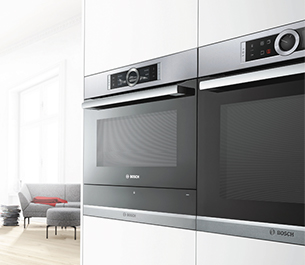
Pyrolytic Ovens
Put simply, these are ovens that clean themselves. The oven uses an extremely high temperature of over 400°C to burn food grime and mess into ash. For the utmost safety in your kitchen, the oven door locks while the pyrolytic cleaning cycle is in progress (which lasts for around 1.5-2 hours). Then you simply wipe the oven clean with a damp cloth to remove the ash. If cleaning an oven is something you dread, this is the oven for you. Traditionally, when performing the pyrolytic function, racks and all dishes need to be removed and cleaned separately. Some brands now offer ‘pyrolytic-proof’ oven accessories, but not all, so enquire if the brands you want has the convenience of ‘pyrolytic-proof’ accessories.
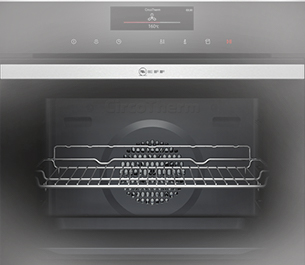
Catalytic Liners
Catalytic liners will allow cleaning at a much lower temperature, meaning it offers the flexibility of cleaning while you cook and are characterised with a rough appearance. Catalytic oven liners are specially treated and designed to trap grease. At around 200’C this trapped grease will then be converted to dust that sits on the liners and on the bottom of the oven to easily wipe out. The liners have a limited life span and need to be replaced when they stop being effective.
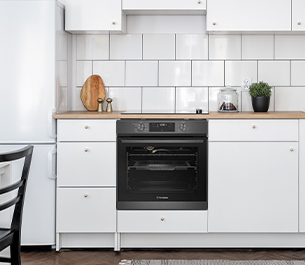
Steam Ovens
Steam ovens come as steam only or as a combination steam oven which enables traditional convection cooking with steam. Steam cooking offers multiple benefits including faster cooking times, retained flavours and nutrients and the ability to cook food over multiple shelves without combining flavours. A steam oven is not designed to replace your standard oven but provides extra versatility in the kitchen.
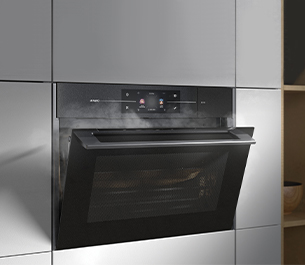
COMBI MICROWAVE OVENS
Combi Microwave Ovens offers a combination of convection cooking with microwave power to help you defrost, warm or reheat meals with the one appliance. Instead of having an oven and a separate microwave, a Combi Microwave Oven helps save you space yet it performs the task of both appliances. Combi Microwave Ovens are usually smaller than your typical oven to easily fit into a microwave placeholder.
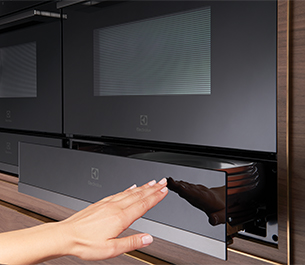
MULTI FUNCTIONAL DRAWERS
Enhance your suite of kitchen appliances with a multi-functional drawer like a Warming Drawer or Vacuum Seal Drawer. A Warming Drawer can warm plates, cutlery and cups before serving and some models even have a ‘keep warm’ function so that you can warm food before plating it up. A Warming Drawer is a must have if you want to recreate the restaurant experience at home. Vacuum Seal Drawers, on the other hand, are great if you like to vacuum seal your food to keep them fresh for longer. Many Vacuum Seal Drawers also offer Sous-vide cooking so that you can seal the food, retain nutrients and flavours as the food is then cooked in the bag either in a water or steam environment.
THINGS TO CONSIDER
The oven you choose will be greatly impacted by the space you have available and also your cooking needs, so here are a few things you should consider…
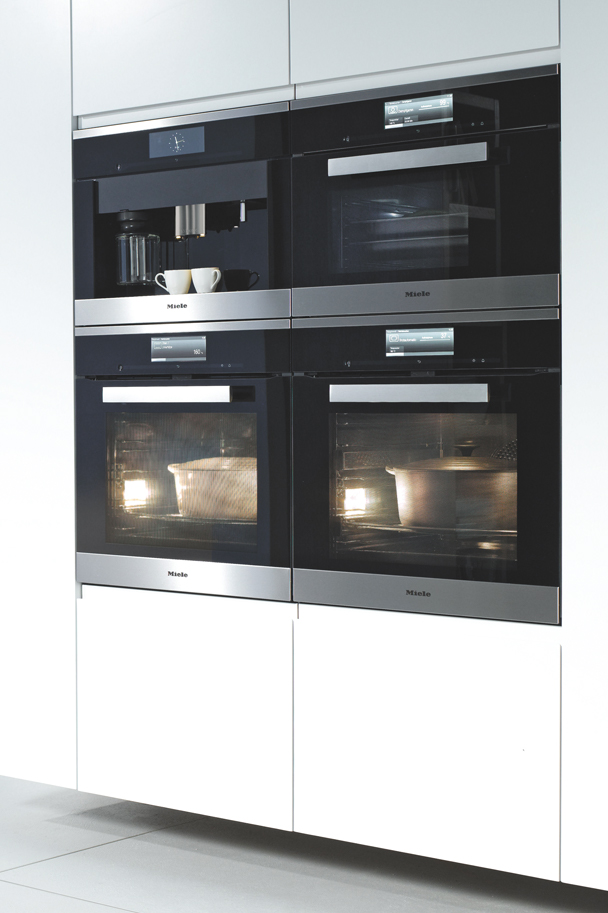
What are the dimensions of where your oven will go? And what is the space around it? Just because ovens may look the same size on the outside, they can vary with the useable space on the internal cabinet.
How many people are you going to be feeding and therefore how big should your oven be? Oven capacity is measured in litres and you will see both net and gross litres quoted. If you are comparing ovens, you should
ask for both measurements to make sure you are comparing the same measurements.
Which functions will make your life easier? Ovens have a range of functions, from fan and grill settings, upper and lower heating elements, steam cooking, self-cleaning, safety features and more, it’s important
to select those that will best suit your needs. Before you shop around, make sure you know how you use your oven and the current functions you use. More functions generally increase the cost, evaluating your
needs before shopping may help prevent you from paying for functions you won’t use.
Built-in ovens need to go in an oven housing unit and are installed as a part of the cabinetry. Consider the outside finish, whether you want glass doors providing easy viewing access or a Stainless Steel option
to match other appliances. Also check the handles to make sure they fit with your design plan for your kitchen.
Oven controls range from simple knob operation to full colour touch screens with step by step guidance. Depending on your cooking lifestyle, you’ll have a preference of one over the other. Ensure you choose an oven
interface or controls that you will enjoy using for many years to come.
Oven accessories refers to the racks, trays and dishes that are supplied with the oven. With telescopic rails or runners, you can pull out the shelves beyond the front of the oven while the rack remains stable.
This means no more putting your hand into the oven to check part way through cooking or removing the food from the oven. You can often buy these runners separately if you decide down the track you wish to have
this feature, however not all ovens are equipped to have these installed. Before you buy, check to see if the oven can have the racks installed in the future. Another handy oven accessory are Catalytic Liners
which have been treated and designed to trap grease when the oven’s cooking. At around 200°C, the trapped grease will then be converted to dust that sits on the liners and on the bottom of the oven to easily
wipe out. The liners have a limited life span and need to be replaced when they stop being effective.
Pyrolytic oven or steam oven? Knob controls or a touch screen? Featuring so many brands, styles and sizes, our large selection of ovens will satisfy any home cook. Browse oven models, view them in your home and even read real reviews, all in one place, all before you buy!
Are you after a stylish cooker to suit your newly renovated industrial-style décor, on a budget and looking for an all-in-one cooktop and oven, or perhaps you’re replacing an old unit? With a wide range and new improved features, from the budget-friendly to those with all the bells and whistles, Freestanding Cookers are a versatile option to consider.
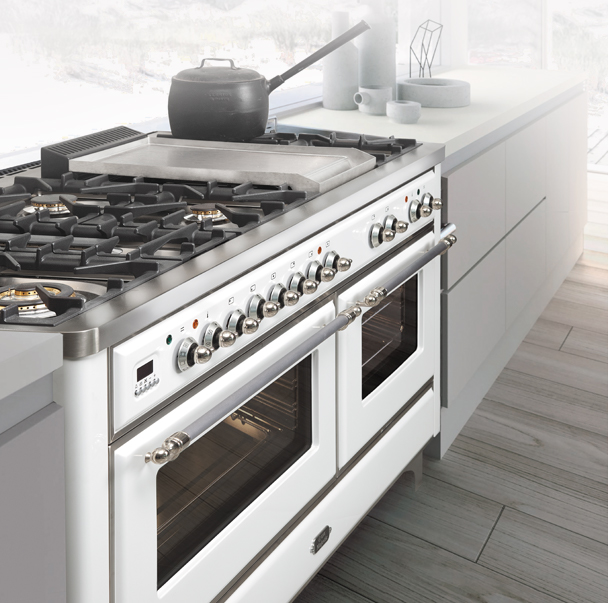
The first thing you need to bear in mind is which combination of elements will suit you best:
- Gas cooktop and gas oven
- Electric cooktop and electric oven
- Gas cooktop and electric oven
- Ceramic cooktop and electric oven
- Induction cooktop and electric oven
When shopping around for a Freestanding Cooker, there are a variety of factors to consider…
What are the dimensions for where it will sit? Freestanding Cookers come in a variety of sizes – slim line to wide industrial-sized, the choice is yours to make, depending on your kitchen’s space and your cooking
lifestyle.
What Freestanding Cooker size will suit your needs? The most common size for Freestanding Cookers are 60cm in width, with 90cm and above being popular for larger families or home entertainers. Choose a size that
will work for your lifestyle in the kitchen, for example, if you don’t cook often, purchasing a 60cm Freestanding Cooker instead of a 90cm model is a sound decision.
Due to the unique nature of a Freestanding Cooker having both an oven and a cooktop, there are a myriad of functions and features that come with it. Knowing what you need and don’t need in the kitchen would be advantageous
when you go shopping for a new Freestanding Cooker. Ask yourself the following:
- Is the oven self-cleaning? If it’s a wide model or you use the oven often, will you be thankful for this feature to help with the cleaning process?
- Are the controls easy to view and use?
- Does the oven have any child or door locks and a cool oven door?
- Is the burner layout on the cooktop efficient? Having the burners you use most at the front is not only more convenient, it’s also safer so you’re not leaning across an open flame when cooking.
- What accessories would I need for both the oven and cooktop to maximise my cooking?
- Do I need the space of a storage drawer that’s built into the Freestanding Cooker?
Fall in love with the convenience of a Freestanding Cooker. With so many brands, styles and colours to choose from, you’ll find your perfect fit for your kitchen. View a wide selection, read reviews and find them at your local retailer today!
Gas, ceramic or induction? Cooktops are often referred to as hobs and are an important part of the kitchen. Depending on who you talk to you could get many different answers as to which is the best. It all comes down to preference and how you like to cook, so here is a guide to the basic benefits of each:
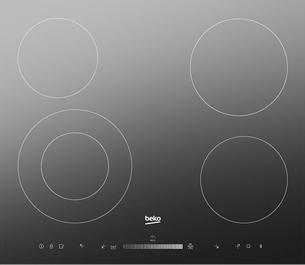
Induction
Fast cooking, immediate control, cool touch (little residual heat left of your hob) and energy efficient.
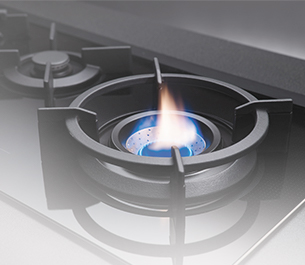
Gas
Provides instant heat but has sensitive heat control and may overheat your kitchen during the warmer months.
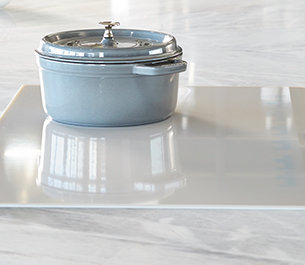
Ceramic (Electric)
This sleek cooking surface is easy to clean and install however it offers a slower heat-up rate when compared to Induction models.
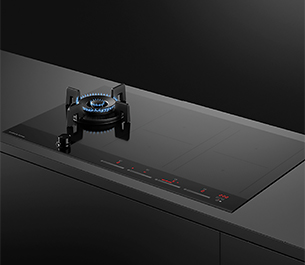
HYBRID COOKTOPS
These cooktops offer the versatility of Gas and Induction cooking on the one hob. A Hybrid Cooktop often has a Wok Burner, making it a great solution if you enjoy the smart control of Induction cooking but also appreciate the high
heat of gas cooking in your kitchen.
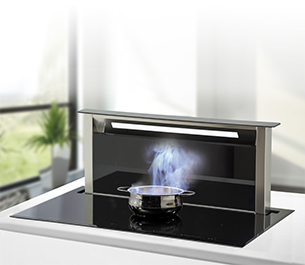
COOKTOP WITH INTEGRATED VENTILATION
Cooktops with an integrated rangehood are ideal for kitchen islands in an open-plan kitchen or if you simply don’t have space for an overhead rangehood. Usually, the cooktop is an induction model with ventilation that works in
a ‘downdraft’ manner as it ‘pulls’ the smoke, steam and grease down a filter and duct that is then carried outside your home. In some models, the ventilation part of the cooktop pops up from the cooktop surface to then pull
and remove the unwanted smoke and cooking odours.
THINGS TO CONSIDER
Below, we share some of the things you should consider when buying your new cooktop.
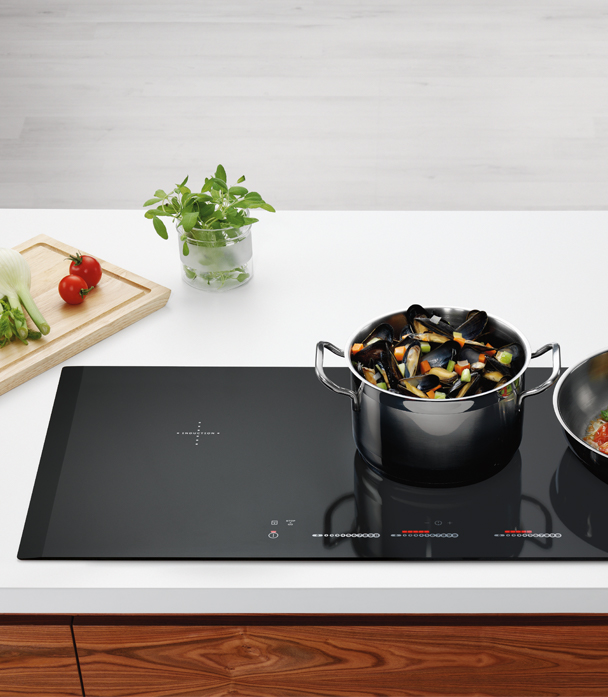
What are the dimensions of where your cooktop will go? And what is the space around it? Do you need to upgrade to have more cooking zones or will you be getting something that is similar to your old model? The most
common cooktop size is 60cm, with 90cm models becoming increasingly popular as they offer more cooking space.
Do you cook with large baking dishes or are you more of a small sauté pan cook? Make sure you look at the burners or zone configuration before you buy and see what suits what you use most. You may find that sometimes the two burners you would use most at the same time are next to each other and when you put both pans on, they don’t fit when on the cooktop at the same time. Taking into account where the controls are is important as well, especially if you prefer them on the right hand side then the front.
Induction cooktops generally require specific cookware to be used on them, so factor this into your budget.
Have a look at the power or temperature settings – generally, the more temperature control settings, the more expensive the cooktop is. If you prefer precise heat control and want greater functions like a ‘pause’
feature or a setting lock, then the investment on your cooktop will pay off.
Touch, knobs or slider be sure to test run the controls before you buy. If you chose something with knobs check that it matches the knobs on your oven as best as possible.
Cooktops come in a variety of colours and finishes from Stainless Steel to glass, matte and colour options such as Grey and White.
It doesn’t matter if you cook occasionally or cook daily, having the right cooktop in your kitchen is essential. A cooktop is an asset to making quality home-cooked meals and it’s vital that you choose one that fit your needs. View our wide cooktop varieties online, read reviews and find them at your local retailer today!
There are many rangehoods options on the market, but the choice will ultimately come down to the space you have, the layout of your kitchen as well as your cooktop choice. Below, we’ll outline the types of rangehoods available and the factors you should take into account when purchasing a new one.
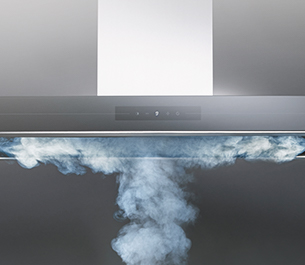
Wall Mounted Canopy rangehood
Canopy rangehoods are installed against a wall over the cooktop and not installed into the cabinetry, they are a design feature themselves.
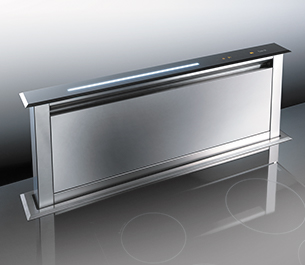
Island rangehood
Island rangehoods are a canopy style rangehood but installed above an island bench from the ceiling.
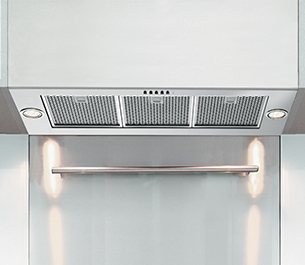
INTEGRATED RANGEHOOD
These are often referred to as Undermount, Concealed or Built-In Rangehoods. An Integrated Rangehood is basically built into your kitchen cabinetry. They are a popular choice in designer kitchens as they are hidden from sight when
not in use. Perfectly streamlined and stylish but functional at the same time.
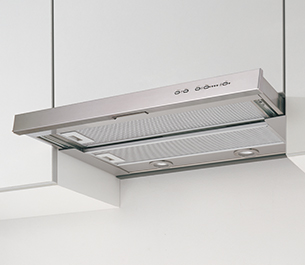
Slide out rangehood
Also known as Retractable Rangehoods, Slide Out Rangehoods are great space savers. Installed into the kitchen cabinetry above the cooktop, simply slide the hood out and switch the rangehood on and once you’re done, you can push
it back in and out of sight.
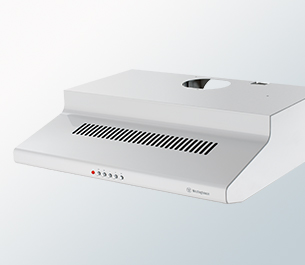
Fixed rangehood
Fixed Rangehoods are as the name suggests, fixed to the wall and not designed to be installed or concealed into cabinetry. They are generally not as attractive as the other types of rangehoods but are perfect for those on a budget.
THINGS TO CONSIDER
When shopping for a new rangehood, there are a number of things you need to keep in mind…
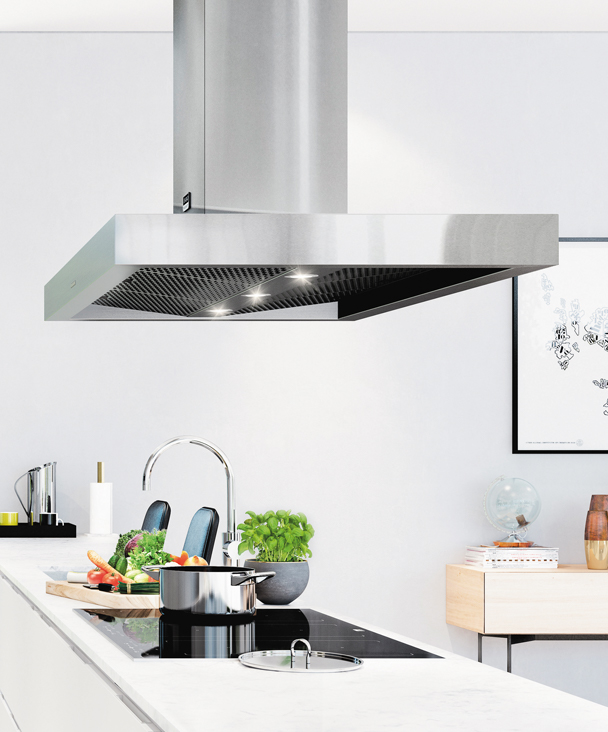
You may be limited by the area above your cooktop as to what type you can choose. Before you start looking you must measure the space you have.
or
Recirculating
You must decide if you want your rangehood to be ducted or not. Ducted simply means it takes the air out of the kitchen and sends it outside through piping installed. The alternative is a recirculating rangehood
that recirculates the air via a filter, which cleans the air before sending it back into the kitchen. Grease and oil are captured in the filters that need to be cleaned and maintained or replaced regularly.
Many brands now offer dishwasher safe filters that will make cleaning easy.
Recirculating is not as powerful as ducted, but if you are unable to use ducting, it’s a good alternative.
or
Extraction Rate
The airflow power of a rangehood is measured in m3/hour. The higher the air extraction rate, the greater the amount of air will be removed from your cooktop. The power levels you need will depend on the type of
cooking you do, for example, if you wok a lot, consider a high extraction rate of over 700m3/hour.
There is nothing worse than not being able to see what you are cooking! But on the flip side, you do not want to be blinded as you whip up your dinner. The choice will come down to preference so be sure to test
out the lighting in store as some have dimming functions. Also check the lights’ lifespan and that the replacement globes will be easy to buy and replace.
Do you live in an open plan layout where others may be watching TV or relaxing in an adjoining lounge area as you prepare dinner?
New technologies mean the rangehood motors can now have an off-board motor, meaning the motor or part that makes the noise is installed in the roof instead of being part of the rangehood in your kitchen. This means
that the noise is significantly reduced almost to a silent operation.
Rangehoods come in a variety of colours and finishes to suit, from Stainless Steel to White and with every colour in between such as Red and Black.
Rangehoods, there’s one suited for every kitchen and lifestyle. With so many different types of rangehood designs to choose from, you’ll love browsing our huge range to find your perfect fit. View the latest models, read reviews and then find them at your local retailer today!
Here, we’ll help you choose the right dishwasher by outlining the models on the market and share some of the features and functions you should keep an eye out for.

Freestanding
Many kitchens have a dedicated, open spot for the dishwasher, usually next to the sink, so it is convenient to stack and the waste water can be connected to the pipes. A freestanding dishwasher can stand alone at the end of the bench with a hard top and sides.
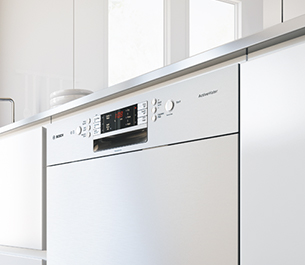
Built Under
Unlike the freestanding model, a built under dishwasher simply fits in the dedicated spot under the lip of the bench top. It does not have a hard top and is fixed into the surrounding cabinetry.
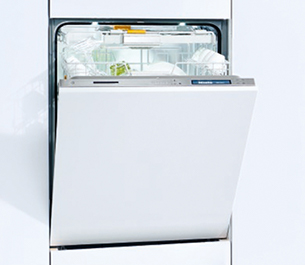
Integrated
Dishwashers can also be integrated into your cabinetry for stylish uniformity. You can choose between a fully or semi-integrated dishwasher. Fully-integrated means the dishwasher is seamlessly hidden behind the cabinetry and matches in with surrounding cabinets, while a semi-integrated model allows you to see the settings and dials, with the body of the dishwasher hidden behind a door panel specially made to match your cabinetry.
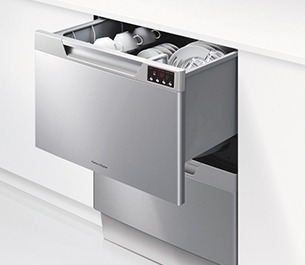
DishDrawer™
DishDrawers™ are available as one or two drawers, which fit ergonomically under the benchtop at waist height. As the name suggests, the drawer design is as easy to use as your normal drawer. Dishdrawer™ comes in a variety of options including single, double and integrated to suit the design or space in your kitchen. A single Dishdrawer™ is ideal for a smaller kitchen while a double Dishdrawer™ allows you to run two different wash cycles at once or gives you the flexibility to run only one, should you only have enough dishes to fill one drawer.
THINGS TO CONSIDER
When choosing a dishwasher that will suits your needs in the kitchen, you should factor in the below considerations…
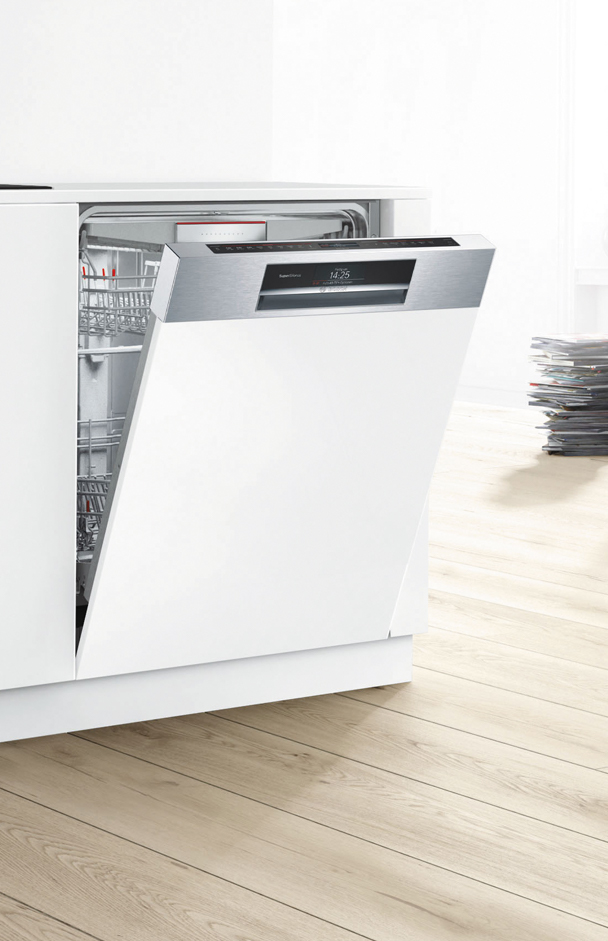
Measure the space you have to fit your dishwasher. If you have higher benchtops you may be able to fit a ‘tall tub’ dishwasher, which is simply a little taller than the standard dishwasher, giving you a little extra
room for dishes. If you are designing a kitchen, it may be worthwhile considering higher benchtops to enable a tall tub to be installed.
Dishwasher capacity is measured in place settings – essentially the maximum number of plates and utensils that can fit in each wash. There are three options:
- Regular to full-sized: 12 – 15+ place settings. Ideal for a family of four or more.
- Slimline: 6-9 place settings and is 45cm wide. Suitable for kitchens tight on space.
- Compact: 6 or less place settings. These are often either for the benchtop or smaller homes like a caravan or granny flat.
and
Water Rating
If reducing your environmental footprint is important to you, ensure to inspect both the energy and water rating of your dishwasher before you buy it. The higher the number of stars, the more efficient the dishwasher
will be. To find the latest information on energy and water ratings, please view these sites: https://www.energyrating.gov.au/ and https://www.waterrating.gov.au/
Most dishwashers have a number of different wash cycles you can choose from, catering to all your dish types. From heavily soiled loads to delicate glassware or a half load wash, there’s a cycle for every need to ensure
your dishes come out clean and perfect!
Many dishwashers offer innovative shelving flexibility with adjustable shelves and cutlery trays or baskets. Some cutlery shelves are full width and others ¾ width to enable long stem glasses to fit in the top shelf.
Not all dishwashers have the same configuration or flexibility so it’s vital to look inside, see how easy or hard it is to change the shelving to suit your changing needs.
Enjoy watching TV or heading to bed while the dishwasher operates quietly. Dishwashers have noise level ratings, indicating how loud it is when in operation. The noise level is expressed with a ‘dBA’ rating, with a
larger number meaning a louder operation. If possible, purchase a dishwasher with a lower noise rating for your comfort.
Built-under, integrated or maybe a DishDrawer™? Whatever your cleaning needs in the kitchen, there’s a dishwasher to match! Once you know what your space and cleaning requirements are, browse through our extensive range of dishwashers with many styles, sizes and colours to choose from, with all the biggest brands on-site!
Do you want to cook your meals quickly to perfection? Do you need to defrost something or reheat leftovers? Microwaving is the most energy efficient type of cooking as it’s fast and has a low running cost. There are three types of microwaves on the market:
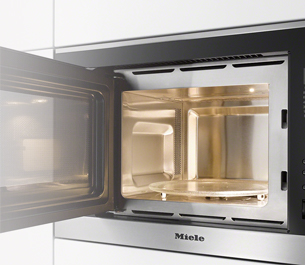
Conventional
These are often referred to as standard microwaves. They are generally more simple in functions, no fuss and handy for heating pre prepared meals on the run or for simple defrosting.
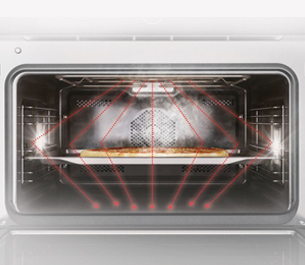
Convection
Often referred to as ‘combi microwaves’ These provide more variety in cooking than a conventional microwave, allowing you to adjust the settings for browning, crisping and baking as they have the addition of a grill and fan. It
is a useful addition to your standard cooking appliances, providing you extra space when cooking for many, or a simple and fast alternative when cooking for few.
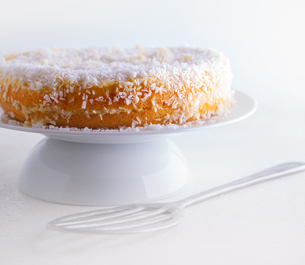
Steam
For the ultimate in microwave flexibility, by adding steam to your microwave cooking, you can achieve more tender and delicious results while retaining nutrients and flavours. Steam microwaves offer steam functionality as well
as a combination of microwave with grilling functions.
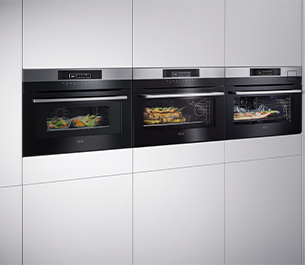
BUILT-IN COMBI MICROWAVE OVEN
These types of microwaves are built into the oven, making it a compact and space-saving 2-in-1 solution if you’re tight on space. Often a Built-In Combi Microwave Oven is smaller than your typical oven but it offers similar cooking functions such as fan baking, grill and convection cooking with microwave heating options available for when you need them.
THINGS TO CONSIDER
Shopping around for a new microwave? Keep the below factors in mind when you’re doing your research.
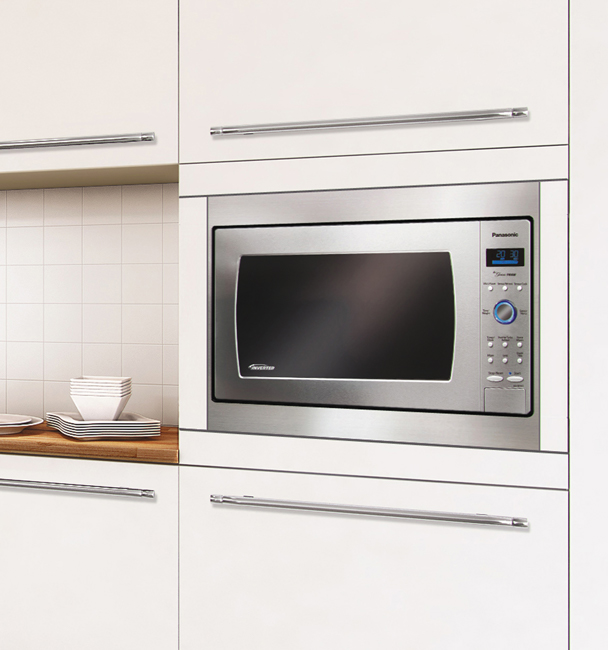
Inverter technology was designed to assist in achieving more even heating results. If you want to heat something at 50% power level, a non-inverter model will switch between off and full power setting to provide an
average 50% heating. Inverter technology allows the power to be regulated and in this instance, will provide consistent 50% power level across the total heating time, meaning your foods are heated evenly throughout.
With Inverter technology, you can say goodbye hot exteriors with a cold centre!
Do you have a dedicated spot or will you have to give up benchtop space? If you’re putting your microwave into a dedicated spot, you may want to consider a trim kit which will frame your microwave in your kitchen, providing
an integrated look.
Microwaves generally range between 20 to over 40 litres in capacity. How you use your microwave and where it will be housed will impact on which one is best for you. A larger capacity allows you to fit larger plates
and prepare more food, but if you’re only reheating or defrosting, a smaller option will suffice.
Are the microwave functions easy to understand and control? If you just need simple defrosting, reheating and cooking then a simple press and go model will be ideal. However, if you want more control over the power,
a microwave with advanced control options will give you that flexibility.
More often now, you will have the option of flatbed technology or the traditional turntable when buying a new microwave. Flatbed microwaves are simply without the turntable and give you a larger cooking area as it doesn’t
require space for the turntable to rotate. Flatbed designs also eliminate the need to remove the turntable to clean the bottom of your microwave.
Microwaves – they’re the trusty kitchen companion that you use daily! Get one that will satisfy your space and your cooking and reheating needs. Browse our range of microwaves from the leading brands and read reviews before buying them online or at your local retailer!
Sinks and taps, they’re the unsung heroes of any kitchen. Whether you’ve noticed it or not, sinks and taps are used on a daily basis, helping you wash fresh produce, prepare meals and clean up afterwards! For some homes, a waste disposal system is vital too, helping eliminate food waste safely and discreetly. With so many styles and colours to choose from, we’ll help you find the right sink, tap and waste disposal unit that’s fit for your lifestyle.
A sink serves many purposes, it’s a place to wash your hands, wash produce or prepare food and washing up dishes, pots and pans afterwards. Whatever you get up to, ensure a sink that you purchase meets all your needs and suits your space. Below, we’ll guide you to the different types of sinks that are available and the various types of installation methods to best suit your kitchen’s space, design and use.
SINK TYPES
A Single Bowl Sink has just one bowl for you to fill and use. If you’re limited on space in the kitchen or only need the sink to rinse before placing dishes in the dishwasher, then a Single Bowl Sink will be ideal. If you’re after a design feature in your farmhouse-style kitchen, a Single Bowl Sink will also work wonders.
1 & ½ or 1 & ¾ BOWL SINK Much like a Single Bowl Sink, these types of sinks feature one bowl and another that might be half or three-quarters of the size, giving you extra space to wash up or prepare food, so that the larger bowl might be used to wash produce and the smaller bowl is to drain them
As the name suggests, Double Bowl Sinks feature two bowls, usually identical in size and capacity. Double Bowl Sinks are great if your kitchen has the space to accommodate and they’re perfect for large families or entertainers who require more washing up space.
Installation
Topmount sinks are installed with the lip of the sink being on top of the kitchen benchtop. This is the most popular installation method and is common for sinks that come with a drainer.
Also known as Bottom Mount, Undermount sinks are installed under the kitchen benchtop with the sink’s frame hidden out of sight. A sink that’s undermount may open up more bench space around your sink.
A Flushmount installation is one that sits half way between a Topmount and Undermount in that Fushmount sinks sit in line with the kitchen benchtop. Upon initial look, a Flushmount looks similar to Topmounts, but the sink is level with the worktop, giving it a seamless, integrated design.
When shopping around for your new sink, there are a lot of factors to consider to ensure your experience in the kitchen is as enjoyable as possible.
Each bowl in your sink will come with a certain capacity in litres. Remember to find out what the bowl’s capacity is so you’ll know if the sink is suitable or not for your needs.
Whether you have a certain colour or style in mind, sinks are available in a variety of materials and finishes to cater to your needs. The most popular sink construction is Stainless Steel, with Granite Composite (composed of 80% granite and 20% resin) becoming increasingly popular. Durable Cast Iron sinks are great for a classic look while sinks with a Copper or Grey coated steel are perfect for a bold design.
Depending on your current or new kitchen sink and tap set up, you may need to have a sink that comes with a tap hole. While the tap hole can be overlooked, always check so you know where your tap is going – installed into the sink or outside of it. Where the waste basket is placed is also important, if the waste basket is towards the back of the sink, the piping will be the same, leaving you with more space for under-sink storage.
A sink is more than just a sink when you have additional accessories to help make your kitchen more functional. Some sinks come with a drainer which is a great place to put a dish rack for air-drying dishes. Other accessories may transform your sink into a food preparation space, thus clearing the kitchen benchtop, some of these accessories include: chopping board, colander, drainer tray and rollamat.
 Quick Tip – Look out for sound deadening technologies in your sink which will reduce the amount of noise when you’re running water into the sink.
Quick Tip – Look out for sound deadening technologies in your sink which will reduce the amount of noise when you’re running water into the sink.Sinks are a practical, functional and can even be a stylish statement in your kitchen. Whatever size, type or colour sink you need, there’s one to meet all your requirements. View our large range of sinks from leading brands, read reviews and find them at your local retailer, all in one place.
Taps – they provide access to water for washing fresh produce, rinsing dishes, washing your hands and even water for drinking. A kitchen is not complete without running water so it’s vital that your new tap meets your needs in the kitchen.
TAP TYPES
Taps – they provide access to water for washing fresh produce, rinsing dishes, washing your hands and even water for drinking. A kitchen is not complete without running water so it’s vital that your new tap meets your needs in the kitchen.
The most common tap type on the market, a Mixer Tap is a tap with one single handle that lets you access both hot and cold water. If you wanted hot water, you would move the handle to one side (usually left) and if you’re after cold water, you move the handle to the opposite side (right). Mixer Taps are simple in design and fit well with many kitchen layouts.
A Pull Out Tap is like a Mixer Tap however it features a pull out tap nozzle. Using the pull out tap nozzle, you can guide the water to the corners of sinks or around large trays, pots and pans which is great for when you’re trying to remove stubborn grease and grime.
If you need quick access to boiling, chilled or sparkling water, then a filtered water tap is perfect for your kitchen. From ensuring the kids have access to clean drinking water to making a quick cup of tea or mixing a refreshing drink, a filtered water tap removes the need to have a kettle. Depending on the model, some filtered water taps may only provide chilled filtered water and some may have chilled and boiling water, which is sufficient for many households. However, if you entertain often, then a tap with chilled, boiling and sparkling water all in one will be the tap for you. Keep in mind that having a filtered water tap means you will need to have space for the filter to sit near the tap as well.
Shopping for a tap may sound easy, but with some extra thought put into it, your tap will become a life saver in your kitchen. As you research for your new tap, keep in mind the below considerations.
There are many tap shapes available to suit your kitchen’s design and your usage needs. When selecting a tap shape, take into account if the tap can be used over both sink bowls if you have a double bowl sink or whether the tap’s neck is long enough to reach the other side of the sink. Some of the most common tap shapes include: Swivel, Gooseneck (also known as J-Shape), U-Shaped and L-Shaped (right angle).
No matter how the rest of your kitchen is designed, there’s a tap finish to complement. Many taps are available in Stainless Steel and they’re the most popular in many homes. For a pop of modern colour, there’s every shade to suit from Chrome, to Grey, Matte Black, White and even Gold.
While they don’t provide filtered, boiling or sparkling water, some non-filtered water taps have features and functions that are worth considering. For example, some taps have an LED light near the nozzle that’s activated by a light touch to help you see better in dark conditions. A double layered coating on the tap may also help from accidental scalding when the tap’s running with hot water.
When you’re shopping for a new tap, you should be able to access the tap’s water rating. A high star rating with a low litres usage per minute (L/min) will mean the tap is water efficient, helping keep your usage down. Add a tap to your kitchen that you’ll love to use. Whether it’s just for simple washing up or for making drinks and tea, a tap is an essential statement piece in any home kitchen. Find your perfect one today!
A waste disposal unit is great to have in the kitchen if you and your family go through a lot of natural food scraps. Safely and hygienically dispose of the food scraps down the disposal unit where it will then ground the food into fine particles that are then flushed away into the sewage system. Using a waste disposal unit is also more environmentally friendly as your waste won’t be added to landfill.
If a food waste disposal unit sounds like a good idea to you, have a think about the below factors before you go out and buy one.
There are many types of foods you can place in the waste disposal unit, this ranges from soft items such as kiwi fruit and capsicum to peelings, eggshells and harder items like chicken bones and banana skin. What you can put into the unit ultimately depends on the strength of the waste disposal unit, so be sure to check before you buy.
The types of foods you can put into the disposal unit depends on the grinding technology. For example, a waste disposal unit with a 3-stage grinding technology might be able to grind more foods than a model with only 1 or 2-stage grinding technology.
A larger grinding chamber means you can place more food items and scraps in one go. The grinding chamber capacity is usually expressed in millilitres (ml).
Entry-level waste disposal units may have a louder operation than their peers. Ensure to check the noise levels of the unit before you buy.
Safety is paramount in the kitchen whether you’re dealing with hot water or baking a cake. The same goes with using a waste disposal unit. Keep an eye out for safety features like overload protection.
Conveniently and safely dispose of your food waste with a waste disposal unit. No matter how much food waste you produce in the kitchen, there’s a waste disposal unit that will fit your needs perfectly. Browse through a range from the biggest brands, view their features and benefits and find them at your local retailer.
 Quick Tip – Kitchens sell houses. Even if you’re not planning on selling, investing in good quality appliances and smart and functional designs are essential.
Now that you’ve had a quick think about life in your kitchen, there are two pathways for you to explore to help find the right solution for you.
Quick Tip – Kitchens sell houses. Even if you’re not planning on selling, investing in good quality appliances and smart and functional designs are essential.
Now that you’ve had a quick think about life in your kitchen, there are two pathways for you to explore to help find the right solution for you.
ARE YOU

Understand the space
Measure the space of the cavity that your existing appliance is installed in. This includes height, width and depth.
- Is it integrated into the cabinetry or is it freestanding?
- In the case of a dishwasher, does it need to fit under the bench top?
- Do you have plenty of bench space? And therefore space for two cooktops? Do you need to have space to fit a microwave, or is there space for it to be built-in?
- How deep and wide is the cabinetry? Are you restricted in size when choosing a rangehood? Or will it need to be suspended from the ceiling?

Materials and Finishes
Look at the existing finishes in your kitchen.
- Do you want your new appliance to match others?
- Will it be integrated?

Infrastructure
Make sure you understand what type of appliance you have now.
- Does your appliance use gas or electricity or both?
- If you want to change from gas to electricity or vice versa is this possible?

Must Haves
Have a think about the things that are most important to you before you start looking at new products. This will ultimately help narrow your search and save you on time and money.
- Is energy consumption a key consideration for your household?
- Do you want to stick to a particular brand for synergy within your kitchen?
- Function vs design – which is more important to you?
- Is there a particular function you need to have? E.g. Safety features, automatic pre-set functions or Artificial Intelligence?

Understand the space
If you haven’t already, you should get a clear picture of the dimensions of the space you have to use – the length of the walls, height to the ceiling, where windows and doors are placed etc.
Depending on your budget, you may choose to use a kitchen design company, an independent drafts person, an architect or use online tools to design it yourself.

Materials and Finishes
What style of kitchen are you going for?
If you need some inspiration, we recommend you do some research. Browse through our inspirations page and start visiting kitchen showrooms to experience different materials and finishes.
Your choice of kitchen materials and finishes will influence on the appliance design.
- Do you want your appliances to be fully integrated, using the same external material as your cabinets or do you prefer a freestanding model that can offer a simple installation down the track if you need or
want to upgrade?

Infrastructure
Imagine if you designed your perfect kitchen only to find out it’s impossibly expensive because the utilities have to be moved. It is very important to have an understanding of where your gas, water and piping is and if they can be moved if necessary.
- Are you planning on changing from gas appliances to electric or vice versa?
- Do you have gas, or only electricity?
- Is there scope to bring in gas if you want it?
- Will the builders have access to re-pipe gas or water to where you want it?
- You should also consider the most ergonomic layout. For example, you’ll want your dishwasher near your sink and your cupboards in reaching distance of your dishwasher for easy packing away.

Must Haves
In planning a kitchen, you’ll no doubt have some things that are absolute musts.
Here are some questions to ask yourself to help get you started:
- How important is energy consumption to your household?
- Would you like all of your appliances to have the same look and feel?
- Function vs design – which is more important?
- Do you prefer a particular brand? Is it worth considering others?
Whether it’s your groceries, a party platter or some drinks, keep them all cool with a fridge that will suit you, your lifestyle and your kitchen! Now equipped with the different types of fridges available and the important considerations to factor in from our Fridge Buying Guide, we’re confident that you can find your perfect fridge on site!
VIEW OUR KITCHEN APPLIANCE RANGE

















